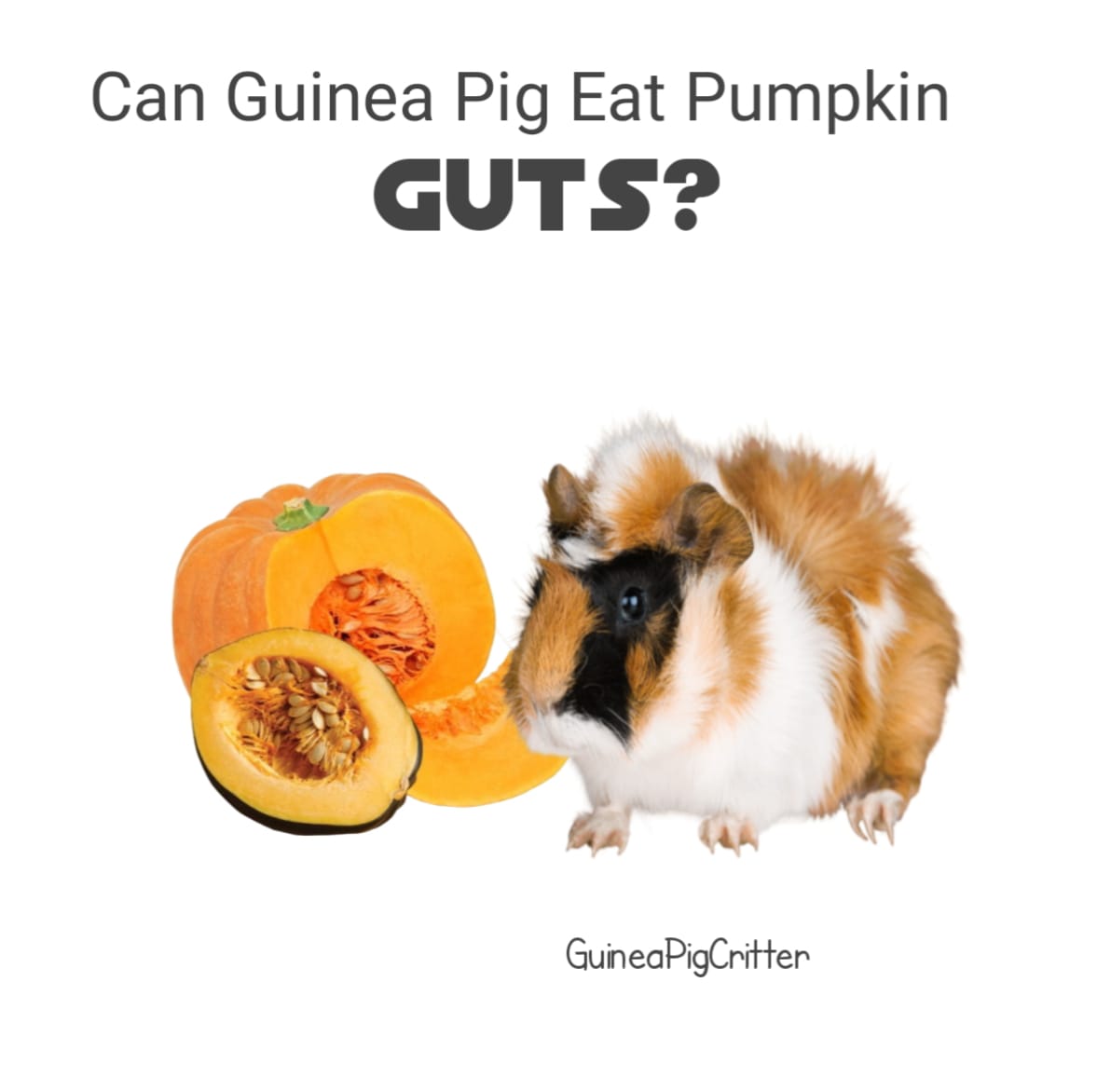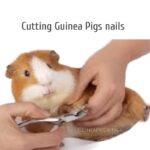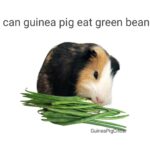Autumn is the time of year famous for Halloween pumpkins that decorate front porches and are widely used to make pies since people enjoy cutting and hollowing the pumpkins to celebrate the season.
But, while pumpkins may be enjoyed by people, many pet owners question whether this delightful treat can safely be shared with their four legged companions. To owners of guinea pigs it is, can guinea pigs eat the inside of pumpkin?
Being herbivorous, guinea pigs have a very sensitive digestive system which requires a lot of fiber in their diet, therefore introducing any new food should always be done with caution regardless of how harmless it may appear.
It’s best to examine why guineas should avoid the insides of the pumpkins, their influence on the pets the insides of pumpkins have, and safe methods for trying to introduce the Halloween classic.
See this post: Can guinea pigs eat cantaloupe?
Today’s question: what are the guts of a pumpkin?
Pumpkin guts, what’s inside of a pumpkin, are mostly made up of:
Stringy flesh: this is what hangs onto the seeds. This is made out of strands of fibers that reach to the shells with the seed. It is usually removed while scooping out the pumpkin’s center, but it has some nutrients within it.
Seeds: the seeds can be quite tiny, are hard and thick in nutrients and are sometimes eaten roasted as snacks. But they are uniquely structured making it some suitable for certain animals, but not all.
Although many people do not know what to do with pumpkin guts and throw them out, some try to make use of them by feeding them to pets like guinea pigs. In order to determine whether or not pumpkin guts have a place in a guinea pig diet, it is important to examine the nutritional value of these components.
Nutritional profile of pumpkin guts
They are the insides and as such are somewhat messy, but pumpkin guts do have some nutritional components that can be of use. Let’s break them down to the core nutrients.
Fiber: as a pumpkin’s mesocarp is rich in fibrous tissues, pumpkin guts have a moderate amount of dietary fiber. Gourds, zucchini and pumpkin are all staple diets for nearly all pets because they prevent unwanted blockages and gastro intestinal stasis. Unlike the hay based fiber that is ideal for guinea pigs, the type of fiber found in pumpkin is somewhat alien and guinea pigs may have a bad time digesting it.
Vitamin c: it’s fair to say that pumpkin’s guts are not that terribly rich in vitamin c but any vitamin c source can be considered useful for guinea pigs. Since they are unable to synthetize vitamin c themselves, guinea pigs are dependent on food sources to meet their requirements. Such insufficiency of vitamin c can lead a person to scurvy, a disease with painful symptoms like swollen joints and tiredness.
B vitamins: as it is well-known, metabolism and energy as a whole are crucial for every living organism, and the metabolic process in turn requires b vitamins, these can also be found albeit in small amounts in pumpkin.
Calcium: although not very rich in this mineral, pumpkin guts have calcium. This is one of the minerals that guinea pigs have to consume in their diet, though too much calcium will result in bladder stones and other urinary problems so this should also be consumed with care.
Potassium and magnesium: these minerals enhance muscle and nerve function, and can be beneficial in small quantities.
Water content: like many other vegetables in this case – pumpkins are roughly 90% water, which is why they are refreshing. Still, a word of caution is required – guinea pigs should not be fed with water based foods often since it possible for their organisms to face digestive issues.
Are pumpkin guts safe for store guinea pigs?
It might be tempting to feed a guinea pig pumpkin guts during Halloween, but it is imperative to note that these rodents have their own unique needs. While pumpkin guts may have some fibrous and moist qualities, their overall approval for these animals is quite mixed.
Stringy flesh: if consumed in smaller amounts, the stringy flesh is usually safe. There may be some digestive advantage from the fiber content provided, but hardly enough to be substituted for hay, which is an essential component of the guinea pig diet. This means that while they may be okay in small amounts, they should never take the place of hay and other core sources of fiber.
The flesh itself contains low quantities of sugar, placing it lower risk in terms of causing weight gain or causing dental issues, but even then, guinea pigs should not eat a large quantity of this food.
Seeds: avoid completely: pumpkin seeds are small, hard seeds that could easily choke a guinea pig, which is why they should not be fed to them. Guinea pigs, unlike other critters that can break seeds using their teeth, have a poor dental structure that can enable them to eat seeds safely.
High fat content: pumpkin seeds are high in fat content, which is something that is not suitable for a guinea pig. A guinea pig may be faced with a number of health problems, including obesity, if their diet is high in fats.
Pumpkin guts and their health benefits for guinea pigs
There are some risks that are inherent in feeding pumpkin guts, but the long strands of flesh also seem to have some very mild benefits when fed in small amounts, which is best done by proceeding with caution. Here’s how:
Improved digestion: the good news is that pumpkin flesh is fibrous and can be helpful in small quantities for guinea pigs experiencing mild constipation. This added fiber may assist in bowel control, but it is not a replacement for hay.
Vitamin c support: pumpkins are not very rich in vitamin c and fruits are used as a supplement. So, this boosts guinea pigs’ health as well making this nutrient an imperative for this breed to consume regularly so that scurvy can be prevented while healthy tissue anatomy can be sustained.
Water: naturally though, they need water all the time and sometimes rather hydrating snacks help. However, excessive water content further beyond measures can make problems in the digestive system, and therefore this must be done in moderation.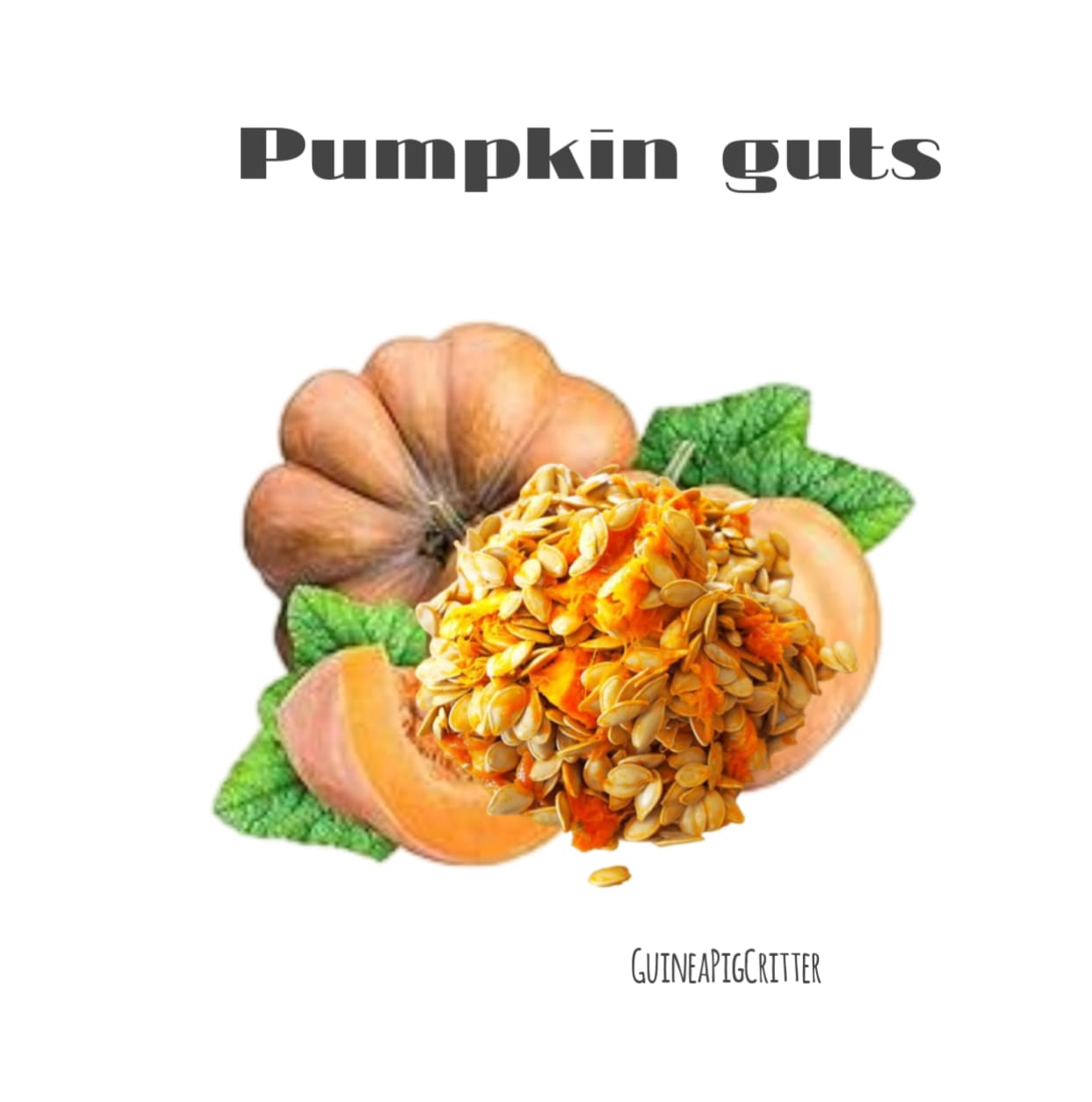
Risks of giving your guinea pigs pumpkin guts
While there may be potential benefits in offering pumpkin guts, there are also the following risks considering their nutrition.
Digestive sensitivity: the digestive system of a guinea pig is rather sensitive and any unusual food items may cause problems to the gastrointestinal tract. Diarrheal or even soft stools may be caused in certain guinea pigs which consume pumpkin excessively due to the fact that it does not form part of their normal diet.
High calcium and fat content in seeds: even though the stringy flesh itself is not rich in fat, the seeds are very much rich in both fat and calcium. Over the normal level of calcium content triggers the formation of the bladder stones, and this condition is common in guinea pigs and may after all cause pain and need intensive surgery to remove it. High fat however is also a difficult food to process for guinea pigs hence such food types cannot and will not help in avoiding obesity in these little animals.
Choking hazard: also as seeds are crazy dangerous mentioned even the least danger is met with seeds. A tiny piece of a seed can easily block the throat up to the whole digestive system which is dangerous.
How pumpkin guts should be offered to guinea pigs
When it comes to offering pumpkin guts as a treat, it should be done very safely and when the time is due. This is how one should prepare and present this completely new treat:
Remove seeds thoroughly: it is of paramount importance that seeds are completely avoided before offering guinea pig any animal that is otherwise dense in calcium to be macadamia nuts or pumpkin guts, as no seeds should be found on them. Even a little bit of seeds are plenty.
Wash the flesh: if the pumpkin is used only as a decoration, you should wash it hard to keep it away from dirt or pesticides or all other forms of germs.
Give them in small pieces: begin with giving only a small pinch, say not more than a teaspoon of stringy flesh. Look for any signs of digestive disturbance in your guinea pig, possibly diarrhea or loss of appetite.
Limit frequency: there should be no more than one treat for every seven days. Try not to feed your guinea pig pumpkin guts more than once a week and only in this pumpkin season to provide variety without overloading their system.
Observe carefully: following feeding, further observe your guinea pig for any new signs or symptoms. Intolerable amounts may also result in changed behavior and activity levels as well as digestive bacteria being “off” with them.
Guinea pig diet basics: the importance of consistency
Guinea pigs are herbivores, which means that they consume a lot of fibrous materials in every meal. Here are their main dietary components in a nutshell:
Hay: hay should act as the principal diet of guinea pigs and account for roughly 80% of their diet. Hay is high in fiber which helps in maintaining good gut health, prevents teeth from growing and getting stuck as well enhances the chances of normal digestion.
Fresh vegetables: vegetables such as bell peppers, cucumber, and leafy greens are ideal for high nutritious levels, providing vitamin c without too much sugar or fat however, these vegetables should be feed in less quantity: spinach and kale.
Pellets: vitamin c is present in some pellets for guinea pigs, which makes them more nutritious. If sugar-enriched pellets or other similar products are used, those vitamins must be included in all pellets and seeds.
Water: providing fresh water is crucial to have easy access to it and keep the guinea pig well hydrated.
This type of diet limits the sugar and fatty or other risky foods grams that might be offered to the guinea pig while making sure to give the required fiber, vitamins and minerals.
Pumpkin guts products: healthy and safer options for guinea pig treats.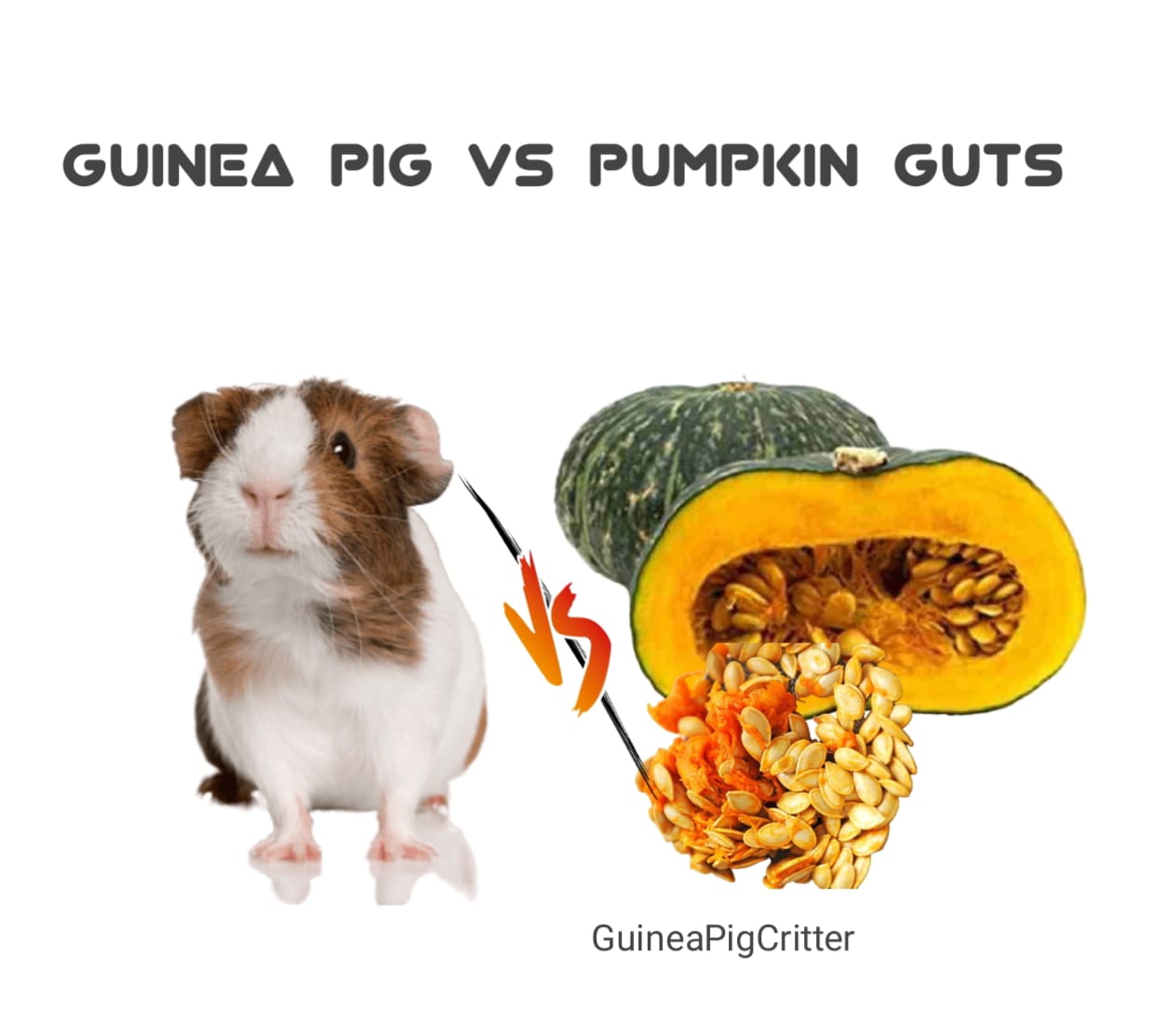
For those who don’t trust pumpkin guts in the first place, here are some other treats for guinea pigs, which are high in fiber, vitamins, and moisture (for hydrating) while not posing the risks:
Bell peppers: a guinea pig has to love these since peppers have a lot of vitamin c, less calcium, and are very crunchy.
Cucumber: with high water content, cucumber provides the guinea pig with hydration without upsetting its tummy, as long as it’s given in moderation.
Carrot tops: carrot tops do not contain sugar from carrots and are safe in small amounts, also providing fiber.
Zucchini: this low sugar vegetable is a perfect addition to any guinea pig’s diet because it promotes variety.
These snacks don’t leave anything to be desired with regards to the nutritional value that you are looking for, since they don’t seem to have the negative sides of pumpkin guts.
Also check :-Can Guinea Pigs Eat Asparagus?
Can guinea pigs have pumpkin guts?
Sharing seasonal foods with our pets can be very tempting as we enjoy the treats ourselves, but guinea pigs have certain dietary deficiencies that make some foods not worth the risk. A bit of the fleshy strands of the pumpkin gut is relatively safe, but a few tiny pieces once in a blue moon won’t risk the health of the guinea pig.
Furthermore, guinea pigs do not actually need any other types of meat or fats as they thrive best on a diet augmented by hay, pellets, and some fresh vegetables. Offering pumpkin guts this way would not be destructive to the cavy’s health as long as it is done sparingly but there are enough other better and guinea pig safe alternate foods.
Conclusion
Pumpkin spice season is a holiday everybody loves and understandably so, however some precautions must be taken and guinea pigs considered before introducing any new food.
Not to say that a small bit of pumpkin guts would be fatal for your guinea pig cavy but it is wise to reserve such food for rare occasions only. For a long, happy, and healthful life for your furry pet, it is advised to stick with a proper guinea pig diet.
